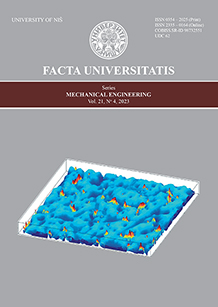抛物槽太阳能集热器系统光学和热性能的最新改进
IF 11.8
2区 工程技术
Q1 ENGINEERING, MECHANICAL
引用次数: 12
摘要
抛物面槽太阳能集热器(PTSCs)通常用于温度高达500°C的应用。近年来,由于PTSCs具有成本和尺寸减小、光学和热性能提高等优点,提高PTSCs的效率一直是研究的热点。本研究综述了PTSCs的制备、性质和实验行为方面的相关研究成果。热模型分析方法给出了稳态和瞬态传热分析。光学效率取决于材料性能,如镜面反射率、玻璃罩透射率、接收器吸收-发射、截距因子、几何因子和入射角。分析和讨论了计算流体力学中用于研究PTSCs物理性质的模型。最后,介绍并分析了PTSC性能和增强方面的研究,包括新设计、增强被动传热和吸收管内纳米颗粒的负载流动。纳米流体已经证明了它们的优点和提高传热速率的能力。此外,还对其他旨在提高PTSCs光热效率的研究进行了评价。本文章由计算机程序翻译,如有差异,请以英文原文为准。
RECENT IMPROVEMENTS OF THE OPTICAL AND THERMAL PERFORMANCE OF THE PARABOLIC TROUGH SOLAR COLLECTOR SYSTEMS
Parabolic trough solar collectors (PTSCs) are commonly used for applications that reach a temperature of up to 500 °C. Recently, improving the efficiency of PTSCs has been the focus of research because PTSCs have advantages, such as cost and size reduction and improved optical and thermal performance. This study summarizes relevant published research on the preparation, properties and experimental behavior of the optical and thermal properties of PTSCs. Analyzing of the thermal modeling method presents a steady and transient heat transfer analysis. Optical efficiency depends on material properties, such as mirror reflectance, glass cover transmittance, receiver absorption–emission, intercept factor, geometry factor and incidence angle. Also analyzed and discussed are the models used in computational fluid dynamics to study the physical properties of PTSCs. Lastly, studies on PTSC performance and enhancement, including novel designs, enhancement of passive heat transfer and laden flows of nanoparticles inside the absorber tube, are presented and examined separately. Nanofluids have illustrated their advantages and ability to increase heat transfer rates. Moreover, other works that aimed to enhance the optical and thermal efficiency of PTSCs are evaluated.
求助全文
通过发布文献求助,成功后即可免费获取论文全文。
去求助
来源期刊

Facta Universitatis-Series Mechanical Engineering
ENGINEERING, MECHANICAL-
CiteScore
14.40
自引率
2.50%
发文量
12
审稿时长
6 weeks
期刊介绍:
Facta Universitatis, Series: Mechanical Engineering (FU Mech Eng) is an open-access, peer-reviewed international journal published by the University of Niš in the Republic of Serbia. It publishes high-quality, refereed papers three times a year, encompassing original theoretical and/or practice-oriented research as well as extended versions of previously published conference papers. The journal's scope covers the entire spectrum of Mechanical Engineering. Papers undergo rigorous peer review to ensure originality, relevance, and readability, maintaining high publication standards while offering a timely, comprehensive, and balanced review process.
 求助内容:
求助内容: 应助结果提醒方式:
应助结果提醒方式:


